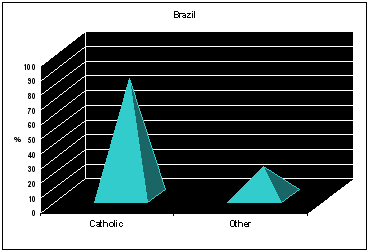 |
|
Brazil
Introduction
Brazil
has a population of 146 Million people concentrated
on its two hundred miles of east coast. Over 90
percent of the people live on 10 percent of the
land, and over 15 Million live in Sao Paulo and
Rio de Janeiro. Brazil’s ethnic composition
is 55 percent European descent (primarily Portuguese),
38 percent a mixture of cultures (African, German,
Japanese, Amerindian, and so forth), 6 percent
African, and only 1 percent Amerindian. Brazil
is a multiparty federal republic. The president
is both the chief of state and the head of the
government. There are two legislative houses: an
81 member Senate and a 503-member Chamber of Deputies.
Portuguese
is the official language, although some of the
population speak Spanish, Italian, or various Amerindian
languages. There is no official religion, however
the predominant religion is Roman Catholic (about
90 percent of the population). Some 16 percent
practice Afro-Brazilian religions that combine
tribal and Catholic beliefs (Spiritual Catholics)
and Evangelical Catholics make up 9 percent. Protestants,
Judaism, Buddhism, and other religions account
for less than 9 percent.
|
|
Brazil
Fun Fact
Brazil
is the World's 5th largest country . . . both
by population and land area.
Nearly
50 percent of the population is under twenty years
of age. Despite massive economic problems, Brazil
is often regarded as a potentially rich country with
a strong industrial sector, large agricultural production,
and rich natural resources. An example of its potential
for efficient utilization of resources is its processing
of sugarcane into ethyl alcohol for fueling 1.5 Million
Brazilian cars.
|
|
|
Geert
Hofstede Analysis for Brazil
|
|
|
The Geert Hofstede analysis for
Brazil is similar to it’s Latin American neighbors. Uncertainty
avoidance ranks highest which indicates a high concern for rules,
regulations, controls and issues with career security – typically,
a society that does not readily accept change and is risk adverse.
A large power distance indicates that inequalities of power and
wealth have been allowed to grow with Brazilian society. High
long-term orientation ranking signifies Brazil has respect for
tradition
and supports a strong work ethic where long term rewards are
expected as a result of today’s work.
Brazil is similar to many Latin American countries
when analyzing Hofstede's Dimensions (see Latin America
Hofstede Graph below).
Brazil's
highest Hofstede Dimension is Uncertainty Avoidance
(UAI) is 76, indicating the society’s
low level of tolerance for uncertainty. In an effort
to minimize or reduce this level of uncertainty, strict
rules, laws, policies, and regulations are adopted
and implemented. The ultimate goal of this population
is to control everything in order to eliminate or avoid
the unexpected. As a result of this high Uncertainty
Avoidance characteristic, the society does not readily
accept change and is very risk adverse.
Brazil has a slightly higher Individualism (IDV) rank
of 38 compared to the average Latin population score
of 21. However, virtually all the Latin countries are
considered to be Collectivist societies as compared
to Individualist cultures. This is manifest in a close
long-term commitment to the member 'group', be that
a family, extended family, or extended relationships.
Loyalty in a collectivist culture is paramount, and
over-rides most other societal rules.
In
many of the Latin American countries, including Brazil,
the population is predominantly Catholic (see
Religions Graph below). The combination of Catholicism,
and the cultural dimensions shown in the Hofstede Graphs
above, reinforce a philosophy predicated in the belief
that there is an absolute ‘Truth”. As Geert
Hofstede explains about peoples with a high Uncertainty
Avoidance Index, their attitude is, “There can
only be one Truth and we have it.”
Brazil
is similar to many Latin American countries when
analyzing Hofstede's Dimensions.
Brazil's
highest Hofstede Dimension is Uncertainty Avoidance
(UAI) is 76, indicating the society’s
low level of tolerance for uncertainty. In an effort
to minimize or reduce this level of uncertainty, strict
rules, laws, policies, and regulations are adopted
and implemented. The ultimate goal of this population
is to control everything in order to eliminate or avoid
the unexpected. As a result of this high Uncertainty
Avoidance characteristic, the society does not readily
accept change and is very risk adverse.
Brazil has a slightly higher Individualism (IDV) rank
of 38 compared to the average Latin population score
of 21. However, virtually all the Latin countries are
considered to be Collectivist societies as compared
to Individualist cultures. This is manifest in a close
long-term commitment to the member 'group', be that
a family, extended family, or extended relationships.
Loyalty in a collectivist culture is paramount, and
over-rides most other societal rules.
In
many of the Latin American countries, including Brazil,
the population is predominantly Catholic (see
Religions Graph below). The combination of Catholicism,
and the cultural dimensions shown in the Hofstede Graphs
above, reinforce a philosophy predicated in the belief
that there is an absolute ‘Truth”. As Geert
Hofstede explains about peoples with a high Uncertainty
Avoidance Index, their attitude is, “There can
only be one Truth and we have it.” More
information on Geert Hofstede
Written
by Stephen Taylor - the Sigma Two Group
|
Religion
in Brazil

*
WORLD FACTBOOK 2011
In
a country that has over 50% of its population practicing
the Catholic religion, we found the primary correlating
Hofstede Dimension to be Uncertainty Avoidance
(UAI). There were only 2 countries out of 23 that
did not follow this correlation, they were Ireland
and the Philippines. (See accompanying Article)
|
Appearance
in Brazil
 Three-piece
suits carry an "executive" connotation,
whereas two-piece suits are associated with office
workers. Conservative attire for women in business
is very important. Also make sure your nails are
manicured Three-piece
suits carry an "executive" connotation,
whereas two-piece suits are associated with office
workers. Conservative attire for women in business
is very important. Also make sure your nails are
manicured
 The
colors of the Brazilian flag are yellow and green.
Avoid wearing this combination in any fashion The
colors of the Brazilian flag are yellow and green.
Avoid wearing this combination in any fashion
 Touching
arms and elbows and backs very common Touching
arms and elbows and backs very common
 The
O. K. hand signal a rude gesture in Brazil The
O. K. hand signal a rude gesture in Brazil
 To
express appreciation, a Brazilian may appear to
pinch his earlobe between thumb and forefinger To
express appreciation, a Brazilian may appear to
pinch his earlobe between thumb and forefinger
 To
invoke good luck, place your thumb between your
index an middle finders while making a fist. This
is also known as the "fig" To
invoke good luck, place your thumb between your
index an middle finders while making a fist. This
is also known as the "fig"
 Flicking
the fingertips underneath the chin indicates that
you do not know the answer to a question Flicking
the fingertips underneath the chin indicates that
you do not know the answer to a question
|
| |
Behavior
in Brazil
 Make
appointments at least two weeks in advance. Never
try to make impromptu calls at business or government
offices Make
appointments at least two weeks in advance. Never
try to make impromptu calls at business or government
offices
 Be
prepared to commit long term resources (both in
time and money) toward establishing strong relationships
in Brazil. This is the key to business success Be
prepared to commit long term resources (both in
time and money) toward establishing strong relationships
in Brazil. This is the key to business success
 Some
regions have a casualness about both time and work.
However San Paulo is not one of those, and in Rio
casual refers to the personal and social events,
not business. In these two cities, business meetings
tend to start on time Some
regions have a casualness about both time and work.
However San Paulo is not one of those, and in Rio
casual refers to the personal and social events,
not business. In these two cities, business meetings
tend to start on time
 Never
start into business discussions before your host
does. Business meetings normally begin with casual
'chatting' first Never
start into business discussions before your host
does. Business meetings normally begin with casual
'chatting' first
 Midday
the normal time for the main meal. A light meal
is common at night, unless entertaining formally Midday
the normal time for the main meal. A light meal
is common at night, unless entertaining formally
 American
coffee is a mere shadow of Brazilian coffee. Expect
to be served small cups of very strong coffee American
coffee is a mere shadow of Brazilian coffee. Expect
to be served small cups of very strong coffee
 In
Brazil, restaurant entertainment prevails versus
at home In
Brazil, restaurant entertainment prevails versus
at home
 If
entertained in the home, it is polite to send flowers
to the hostess the next day, with a thank-you note If
entertained in the home, it is polite to send flowers
to the hostess the next day, with a thank-you note
 Giving
a gift is not required at a first business meeting;
instead buy lunch or dinner Giving
a gift is not required at a first business meeting;
instead buy lunch or dinner
 Purple
flowers are extensively used at funerals, so be
cautious when giving someone purple flowers. Violets
are OK to give Purple
flowers are extensively used at funerals, so be
cautious when giving someone purple flowers. Violets
are OK to give
 Toast: Saude or Viva (Sah-OO-Day,
VEE-va) Toast: Saude or Viva (Sah-OO-Day,
VEE-va)
 Tipping
is typically 10% in Brazil Tipping
is typically 10% in Brazil
 If
you here the term jeito - it refers to
the idea that nothing is set in stone, that a good
attempt can break a rule If
you here the term jeito - it refers to
the idea that nothing is set in stone, that a good
attempt can break a rule
 Considering
sending a gift to someone in Brazil, see gifts to Brazil. Considering
sending a gift to someone in Brazil, see gifts to Brazil.
|
| |
Communications
in Brazil
 Handshaking,
often for a long time, is common. Shake hands for
hello and goodbye; use good eye contact; when leaving
a small group, be sure to shake hands with everyone
present Handshaking,
often for a long time, is common. Shake hands for
hello and goodbye; use good eye contact; when leaving
a small group, be sure to shake hands with everyone
present
 When
women meet, they exchange kisses by placing their
cheeks together and kissing the air When
women meet, they exchange kisses by placing their
cheeks together and kissing the air
 First
names used often, but titles important First
names used often, but titles important
 Music
and long, animated conversation are favorite Brazilian
habits. When conversing, interruptions viewed as
enthusiasm. Brazilians enjoy joking, informality,
and friendships Music
and long, animated conversation are favorite Brazilian
habits. When conversing, interruptions viewed as
enthusiasm. Brazilians enjoy joking, informality,
and friendships
 Portuguese
is the language of Brazil Portuguese
is the language of Brazil
 Good
conversation topics: soccer, family, and children Good
conversation topics: soccer, family, and children
 Bad
conversation topics: Argentina, politics, poverty,
religion, and the Rain Forest Bad
conversation topics: Argentina, politics, poverty,
religion, and the Rain Forest
 Stay
away from phases such as, "Is it true that
everyone in Brazil is either very rich or very
poor?" It is very likely you will be talking
with someone that isn't either one Stay
away from phases such as, "Is it true that
everyone in Brazil is either very rich or very
poor?" It is very likely you will be talking
with someone that isn't either one
|
| |
|
|
|
|
|
HOME
PAGE
|
|
|
|
|
Resources
Geert Hofstede Free
Monthly Newsletter Resource
Page
International
Business Center
|
|
|
|
|
|

Thanks
to the UTD Global MBA graduates who work
diligently on collecting the information for this Website
|
Page authored by: Joni Nicol
|
|
|
|
|
|
|

|



